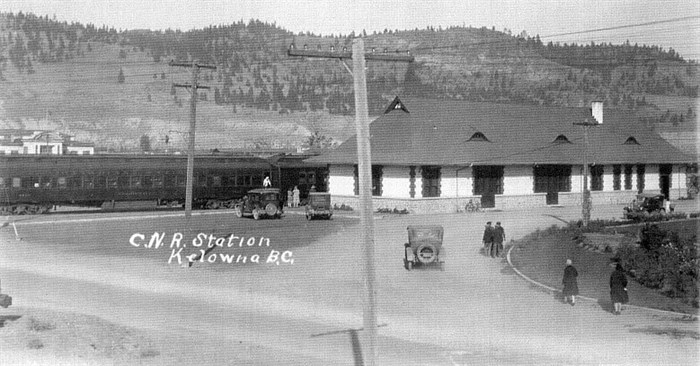
CN Rail Station, Kelowna. Pictured in 1929.
Image Credit: Old Kelowna Facebook Group
December 03, 2023 - 6:00 PM
Railways define Canada’s history and, of course, were a driving force for British Columbia to join Canadian confederation in 1871. Kelowna’s CN Station represents this history and shows how a small fruit growing town could grow into a thriving city.
The CN Railway Station depicts the “Canadian story on a local basis,” Bob Hayes, president of the Okanagan Historical Society, told iNFOnews.ca.
“The train defines Canada as a transportation system,” Hayes said. “It was a case of… the train has arrived, so Kelowna has arrived.”
Railway stations have long been a marker of a city or town’s success in Canadian history, Hayes explained.
“The number of places that were boom places because they thought the railway was going there, and then the railway passed them, and these towns died,” he said. “These places got really excited. So having the train come through your town and have a station there really meant something.”
The station was built in 1926 and marked a new era for Kelowna and its economy. Simply having a train station put Kelowna on the map.
“They're not going to put a railway into a place that's on the skids,” Hayes said. “And even though it was that late, 1925, still I think they were realizing Kelowna was an up-and-coming place.”
These trains weren’t just for trade. They actually offered passenger service until the 1960s and transported locals around the Thompson-Okanagan and further afield across the country.
“I remember riding the train with my brother and two older two sisters up to Vernon,” Hayes said. “My dad worked at the packing house and the trains went right by their place. Mom would get on the train, this would be in the 1950s, and they’d even take my sisters and they would go into town… There was regular passenger service.”
However, this was short-lived as it was neither economically viable nor particularly practical.
The railway appeared in Kelowna at a time where automobiles were becoming more accessible, and the airport and Greyhound buses were just around the corner.
“Places like the prairies got the train in the 1880s, there were no cars then,” Hayes said. “But by the time the train arrived here in 1925, cars weren't rare. So I think it was a case of, well, we'll offer a rail service and see how it goes, and I don't think it took off.”
The CN Station was predominately a key trading point and the end of the rail line.
“(In) most train stations, the train comes and leaves and continues on. Well, here, the train didn't,” Hayes said. “The train cars would go past the train station and be put onto barges and head off to Penticton or Vernon or whatever. But the trains themselves stopped here.”
Because it was an end station, it was constructed with a unique design. A good portion of the building's distinctive stonework was the work of a Scotsman called Sandy Mitchell.
Today, the station is still located on Ellis Street, which is now the home of high rises, pubs and bars. However, it was once filled with industrial fruit packing houses that would rely on the new station to distribute their stock. Because the city was now connected to the rest of the province, its key industry could expand. Its trade was no longer reliant solely on barges travelling north and south on Okanagan Lake.
In its later years the train station was used for freight, before closing down in the 1980s. Hayes said for years the station sat derelict with boarded windows waiting to be demolished.
The station’s later restoration and preservation not only keeps the city’s history alive, but also serves as a reminder of Canada’s building blocks, Hayes said.
“I don't think we could underestimate the train in our history,” he said. “We're reproducing the Canadian story, which is having a railway.”
To Hayes, the CN Station is one of the most important historical landmarks in the city.
“You have the fire hall downtown and the train station, maybe Central School,” he said. “There are about four or five buildings and the train station is always in the top two or three. We love that building.”
Now, standing the same spot as it has been for the last 97 years, the train station has been converted into a popular pub.
The original design of the building has been left in tact and developments nearby must be mindful to the station's important heritage value.
To contact a reporter for this story, email Georgina Whitehouse or call 250-864-7494 or email the editor. You can also submit photos, videos or news tips to the newsroom and be entered to win a monthly prize draw.
We welcome your comments and opinions on our stories but play nice. We won't censor or delete comments unless they contain off-topic statements or links, unnecessary vulgarity, false facts, spam or obviously fake profiles. If you have any concerns about what you see in comments, email the editor in the link above. SUBSCRIBE to our awesome newsletter here.
News from © iNFOnews, 2023